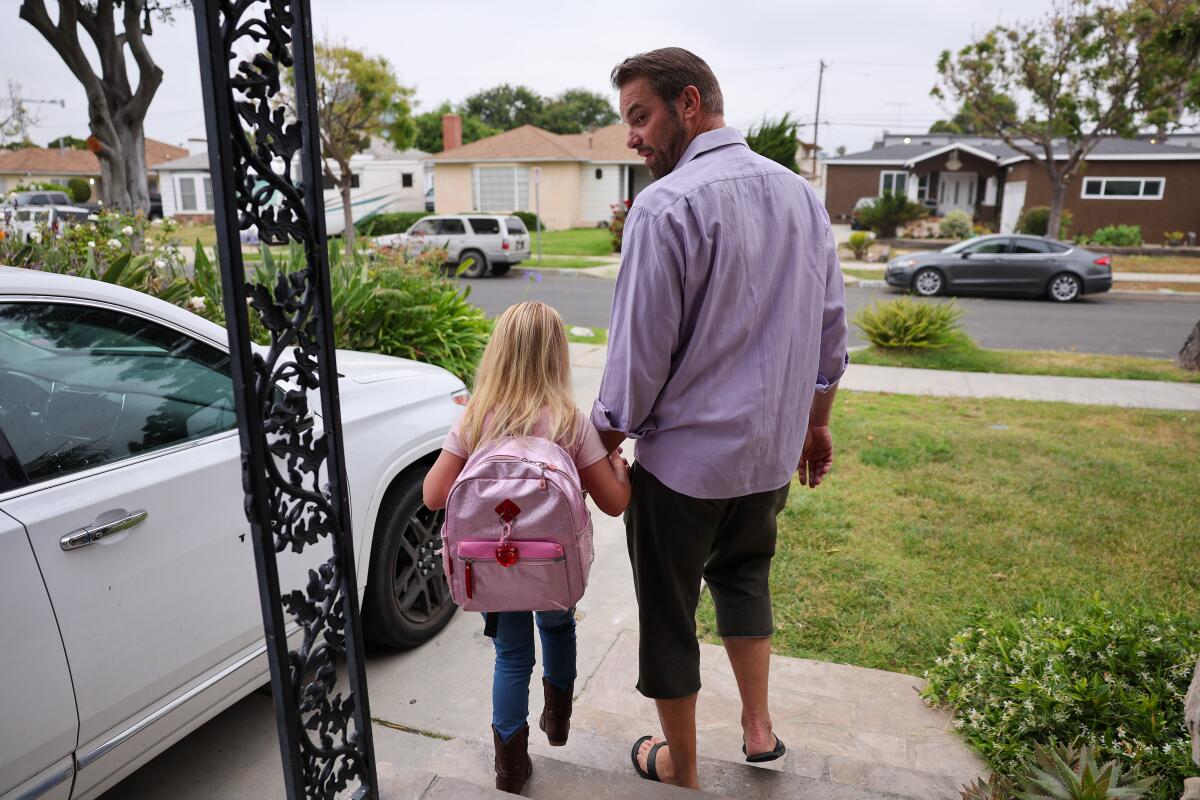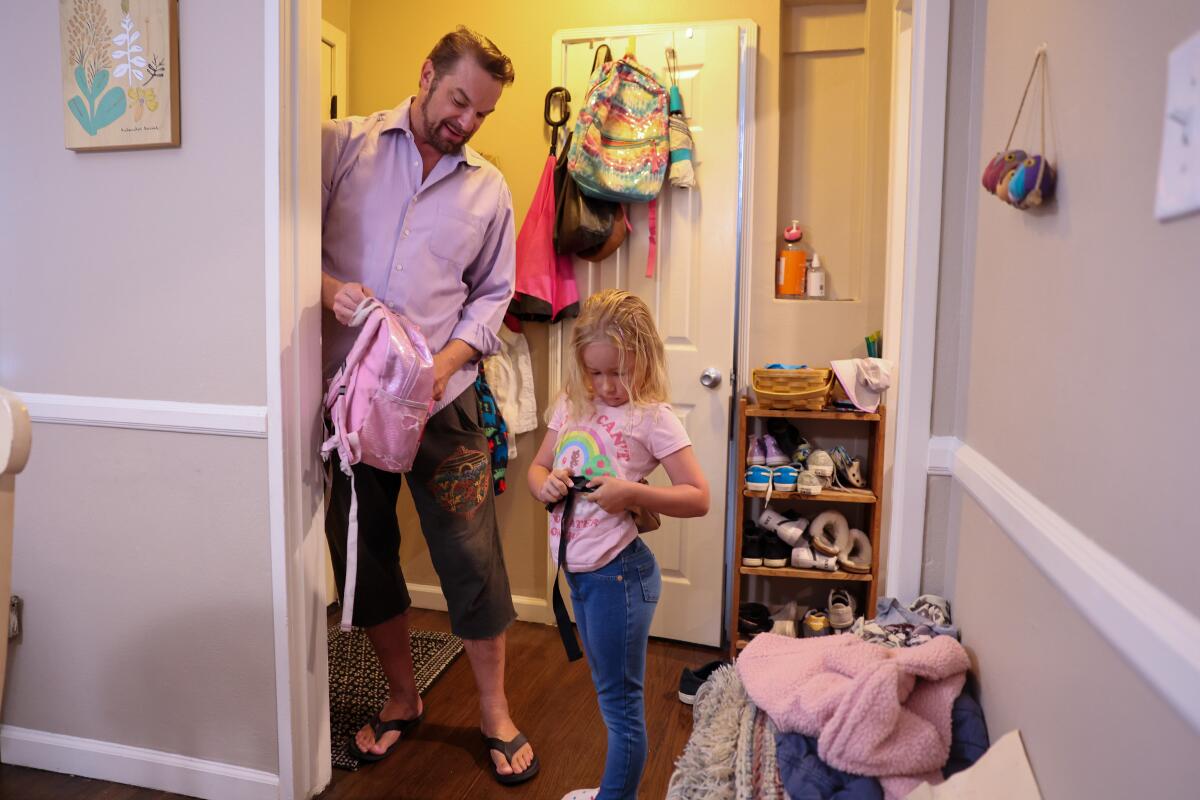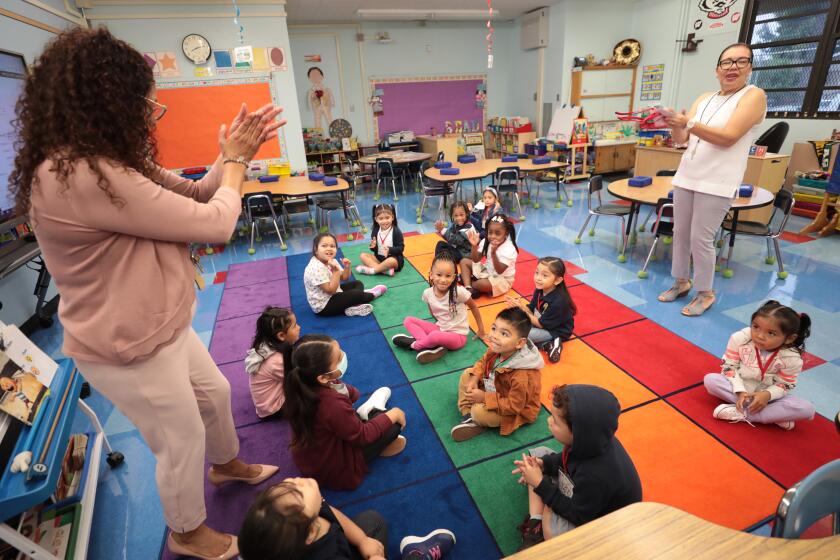LAUSD fined $8 million for staffing violations. Too many students, not enough teachers

- Share via
LAUSD has been fined $8.1 million after an independent audit uncovered classrooms in the district’s highly promoted transitional kindergarten program with too many students and not enough teachers’ aides — a stiff financial penalty that will be withheld from the district’s state funding.
State policies for TK — the new grade level of free public education for California’s 4-year-olds — require classrooms to have a ratio of at least 1 adult for every 12 children and no more than 24 students, and mandate an annual independent audit to make sure districts are in compliance.
Reading by 9’s guide to reading readiness. Find expert tips, book recommendations and resources for parents of kids under age 5.
In a sample of 88 LAUSD schools in the 2022-23 school year, auditors from a local accounting firm discovered two schools where TK classes had an average enrollment of more than 24 children, resulting in a penalty of nearly $7 million. In addition, 20 schools were found to have a student-teacher ratio that exceeded the state limit, most likely because there was no teacher’s assistant present, resulting in another fine of $1.1 million. A total of 19 additional adults were needed in those classrooms.
In a statement, a spokesperson for LAUSD called the financial penalties “egregious” and said that the auditors had found only minor violations of a single student over the class size limit.
The penalty for class size violations is so high because the fine is not based on the number of rule-breaking schools. Instead, it’s calculated using the average daily attendance for TK students in the entire school district, leading to a particularly harsh penalty for the largest school system in California.
But what also concerns LAUSD officials are even stricter ratios that were put into effect this year — and the possibility of more fines in the future.
Assemblymember David Alvarez (D-San Diego), who chairs the Assembly budget subcommittee on education finance, said the penalties are important to maintain the fidelity of the TK program and hold districts accountable.
For the record:
6:58 p.m. June 10, 2024An earlier version of this report referred to Assemblymember David Alvarez as Rep. David Alvarez.
“Some districts were adhering to those rules and worked around being penalized, and still provide a service, versus those who chose to go a different direction with the knowledge of the penalty potentially being assessed,” he said.
The results of LAUSD’s 2022-23 school year audit suggest that the district was already struggling to meet the less restrictive staffing requirements, even before it expanded TK eligibility to all 4-year-olds last fall.
A closer look at TK staffing
L.A. Unified did not release the names of the district schools that were found to be in violation of the requirements in 2022-23. The state requires the annual staffing audits but does not require that districts divulge the names of the scofflaw schools.
LAUSD has made transitional kindergarten testing optional after months of complaints from teachers and parents, who say it’s inappropriate for preschool-age kids.
Out of 2,228 audits of school districts and individual charter schools reviewed by the state, LAUSD was one of only two districts found to have violated both class size and ratio rules, according to documents released by the California Department of Education to The Times. Twelve charter schools across the state were also found to have violated both requirements. The audit results were first reported by EdSource.
Education experts say low student-faculty ratios are crucial in early childhood programs to ensure that children receive enough one-on-one attention from their caregivers and that classrooms are properly supervised. California law requires preschools, which can take in children as young as 36 months, to maintain an even lower ratio of eight 4-year-olds for each adult.
Because schools are required to accept new students throughout the year, ratios and class size requirements can be difficult to balance.
Karina Hanna, a TK teacher in San Pedro who is wrapping up her 30th year of teaching, and her eighth in TK, explained the challenge facing educators. When a new TK student is enrolled in a class already at capacity, one of the older or more advanced students is often bumped up to kindergarten, creating a TK-kindergarten combination class, she said. She recalls a few children “who would cry the whole first week” after being moved.
“Last year was a hot mess,” said Hanna, who helps organize a group of about 80 LAUSD TK teachers and heard frequent complaints from teachers who didn’t have an aide. “A lot of people didn’t even know what the ratios were.”
Deciding between preschool and transitional kindergarten isn’t easy for parents. Here’s how eligibility, structure and academic environment may differ.
The state Department of Education says TK and kindergarten combo classes are permissible but “not ideal,” and requires them to maintain the lower TK ratio and class size requirements.
“I think it’s quite clear these were exceptional cases and not evidence of a broader issue,” said LAUSD school board member Kelly Gonez, who chairs the early education committee. “There will always be hiccups when you have to implement what is essentially an entire new grade of public education.”
She said that although the district was able to recruit and hire enough certified teachers to fill the new TK classrooms, the required aides have been more difficult to find, even in the current school year. “There were some definite staffing challenges in the fall” of 2023, she said, and the hiring process was often slow.
There’s a reason aides are so difficult for LAUSD to hire and retain, said Max Arias, executive director of SEIU Local 99, the union that represents them. Teachers’ assistants earn an average of $22.50 an hour — a 30% increase over the previous school year but still barely enough to put them over the poverty level. They are among the lowest-paid employees in the district, yet the work is physically and emotionally demanding — especially for those who work with young children and must often deal with behavioral issues, Arias said.
With the same amount of money as the fine, Arias said, they could have hired 144 additional assistants.
The district is now monitoring classroom ratio requirements and working with schools to make sure they are in compliance, the LAUSD spokesperson said.
As California public school enrollment declines again, state officials look to transitional kindergarten growth as a promising development.
The scene at one school
At Baldwin Hills Elementary, Alan Canterbury said LAUSD’s problems continue and his daughter’s class is still out of compliance. For the first several weeks of the year, he said, his daughter’s combined TK-kindergarten class had nearly 30 students and a single teacher. Several parents pulled their children out of the class, and by October the number of students had dropped to 24, Canterbury said, but the class still did not have an aide.
He decided to step back from his job to volunteer several hours a day in the classroom, where he observed the environment. The class had descended into chaos, he wrote in a series of emails to LAUSD administrators, which were reviewed by The Times. He pleaded for an aide to be assigned, describing unsupervised bathroom trips, scissor fights, students climbing furniture and throwing objects, and very little instruction.

The teacher was “performing valiantly ... but he is simply outnumbered to such an extreme degree (double the legal limit) that he is not able to manage all of the behavior issues that occur on a regular basis with this age group,” Canterbury wrote. “This is why the state mandates a 12:1 student teacher ratio for this age group. How the school or the District thinks it is acceptable to flaunt that standard by DOUBLE the legal limit is shocking to me and the other parents.”
The district assigned a teacher’s assistant for a few months, but Canterbury said the class is ending the year with only a part-time aide. Several other parents interviewed confirmed his account.
Neither Baldwin Hills nor the district responded to questions about the situation at the school.
Stricter rules to come
LAUSD had moved aggressively to expand its TK program this year and had successfully lobbied legislators to allow it to admit all 4-year-olds, regardless of birthday, two years ahead of the state timeline. But weeks before classes began in August 2023, the state required LAUSD — and other districts that similarly expanded — to adhere to stricter class sizes of 20 students with two adults, usually a teacher and an aide, in classrooms with the youngest students.
Beginning in the 2025-26 school year, that new ratio will apply to all TK classrooms in California.
LAUSD officials said the new rules were handed down last summer with little time to implement.
Dean Tagawa, executive director of LAUSD’s Early Childhood Education Division, urged legislators to take immediate action to waive TK penalties until after the program is fully implemented in the 2025-26 school year. In an April hearing on TK before state budget subcommittees in Sacramento, he also asked lawmakers to amend state statute to allow school districts to seek waivers for all TK class size and ratio requirements that are “beyond their control.”
“The biggest challenge that LA Unified is facing regarding its UTK expansion is the onerous and rigid penalties that have been implemented by the legislature for class sizes and ratios,” he said, referring to the district’s term for TK, universal transitional kindergarten. “I can’t think of another area of education … where districts face multiple overlapping penalties for even very slight shortcomings in staff, staffing ratios and staff requirements.”
“Districts were faced with the decision to either turn away families they had enrolled in TK or be penalized fiscally,” said one letter to legislators, which was signed by 56 districts, including LAUSD. “Many districts chose to serve their families because of the high number of students who depended on the free access to education and care, despite the state’s fiscal penalties.”
So far, legislators have not been particularly sympathetic, and a bill to waive the 2023-24 penalties for early TK enrollments failed in committee.
“Too many districts focus on checking off a box and not the quality and the best practices that it takes to ensure you’re getting the outcomes that you need,” said Assemblymember Corey Jackson (D-Perris), who chairs the budget subcommittee on human services. “Some of these districts who serve so many children of color, it is very concerning that yet another program which is trying to uplift our most marginalized populations again are not getting high quality services.”
This article is part of The Times’ early childhood education initiative, focusing on the learning and development of California children from birth to age 5. For more information about the initiative and its philanthropic funders, go to latimes.com/earlyed.
More to Read
Sign up for Essential California
The most important California stories and recommendations in your inbox every morning.
You may occasionally receive promotional content from the Los Angeles Times.
















